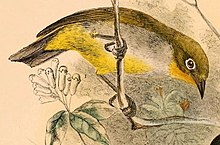| Everett's white-eye | |
|---|---|

| |
| Illustration in Meyer & Wiglesworth (1898) | |
| Conservation status | |
 Least Concern (IUCN 3.1) | |
| Scientific classification | |
| Domain: | Eukaryota |
| Kingdom: | Animalia |
| Phylum: | Chordata |
| Class: | Aves |
| Order: | Passeriformes |
| Family: | Zosteropidae |
| Genus: | Zosterops |
| Species: | Z. everetti |
| Binomial name | |
| Zosterops everetti Tweeddale, 1878 | |
Everett's white-eye (Zosterops everetti) is a bird species in the disputed family Zosteropidae, which might belong with the Old World babblers (Timaliidae). The name commemorates British colonial administrator and zoological collector Alfred Hart Everett. It is only found on the Talaud Islands, Sulu Archipelago and the Philippines. Its natural habitats are tropical moist lowland forests and tropical moist montane forests.
Description and taxonomy
EBird describes the bird as " Typical white-eye; greenish above and grayish below with broad white spectacles around the eyes. Darker gray belly and more extensive yellow on the belly than in the marginally smaller Oriental White-eye. Inhabits foothill and montane forest edges, gardens, and secondary growth, occasionally around human habitation. Gregarious, often foraging in large flocks, both single-species and mixed. Moves through the upper levels of forest, though can descend into middle and lower levels in edge. Song consists of repetitive twittering; also gives whistles and buzzy notes while in flight and when foraging."
Subspecies
Six subspecies are recognized:
- Z. e. everetti – Found on Cebu
- Z. e. basilanicus – Found on Dinagat, Siargao, Camiguin Sur, Mindanao, and Basilan
- Z. e. boholensis – Found on Samar, Calicoan, Biliran, Leyte, and Bohol
- Z. e. siquijorensis – Found on Siquijor
- Z. e. mandibularis – Found on the Sulu Archipelago
- Z. e. babelo – Found on the Talaud Islands
Ecology and behavior
Likely a generalist that feeds on fruit, berries, small insects and nectar. Forages in the understory and often joins mixed-species flocks with other small birds. Breeding season believed to be April to August. Nest is a typical white-eye nest, a few meters above on a small tree. Clutch size 3-4.
Habitat and conservation status
This bird's habitat is primary and secondary forest and scrubland up to 1,000 meters above sea level.
IUCN has assessed this bird as least-concern species as it has a wide range and is fairly adapatable to degraded habitats. However, the population is still believed to be declining due to deforestation in the Philippines continues throughout the country due to slash and burn farming, mining, illegal logging and habitat conversion.
References
- BirdLife International (2019). "Zosterops everetti". IUCN Red List of Threatened Species. 2019: e.T155179593A155180706. doi:10.2305/IUCN.UK.2019-3.RLTS.T155179593A155180706.en. Retrieved 11 November 2021.
- "Everett's White-eye - eBird". ebird.org. Retrieved 2024-09-09.
- ^ van Balen, Bas; Limparungpatthanakij, Wich'yanan (2020). "Everett's White-eye (Zosterops everetti), version 2.0". Birds of the World. doi:10.2173/bow.evweye1.02. ISSN 2771-3105.
- IUCN (2019-08-19). Zosterops everetti: BirdLife International: The IUCN Red List of Threatened Species 2019: e.T155179593A155180706 (Report). International Union for Conservation of Nature. doi:10.2305/iucn.uk.2019-3.rlts.t155179593a155180706.en.
This Zosteropidae-related article is a stub. You can help Misplaced Pages by expanding it. |